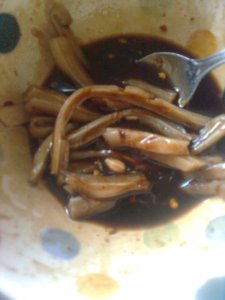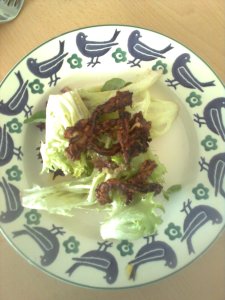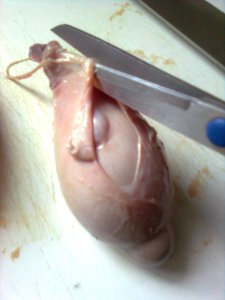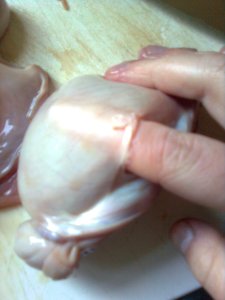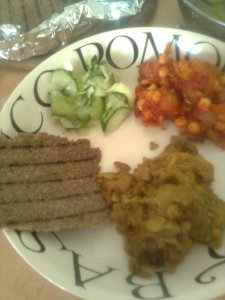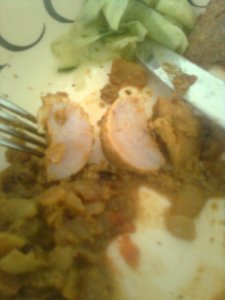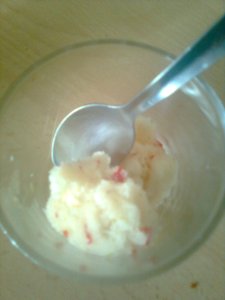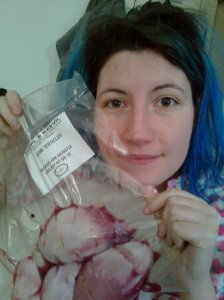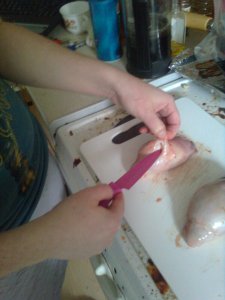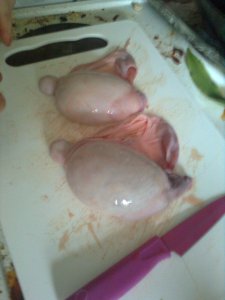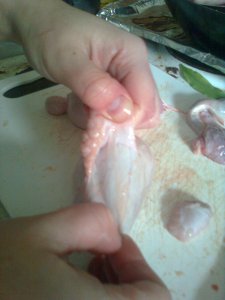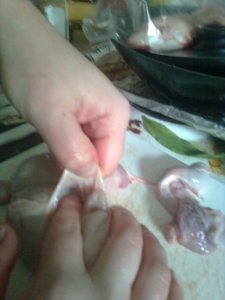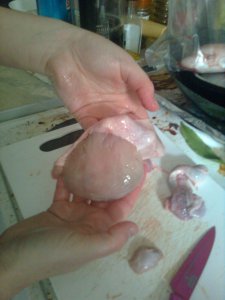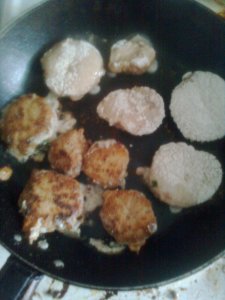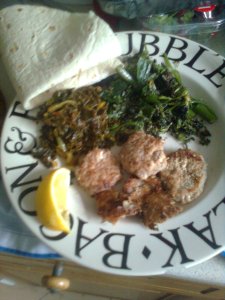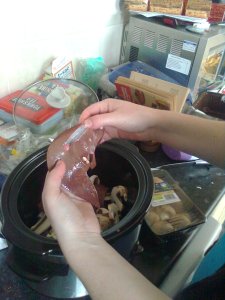Have you ever eaten spleen? I hadn’t until my recent visit to John Penny where I got given a fresh beef spleen to cook with. Prior research from the Offal Club’s page suggested from their experience that spleen was gross. Anissa Helou has a few recipes in The Fifth Quarter for it, which all sound very amazing, so I was excited again. Then I read in Jennifer McLagan’s Odd Bits that she expected that “if you like liver you’ll probably like spleen”. Damned by faint praise indeed. Never one to be deterred I got my spleen out and looked at it. The spleen looked back.
More disturbingly – how filthy was my cooker that day? What a slut! And look how long a spleen is. Long. So what does a spleen do? I always find that thinking about how the organ works can help you get to know how it might be nicely cooked. A spleen:
“… is an organ found virtually all vertebrate mammals. Similar in structure to a large lymph node, the spleen acts primarily as a blood filter. It is a non-vital organ, with a healthy life possible after removal (splenectomy). The spleen plays important roles in regard to red blood cells and the immune system. It also acts as a store of blood in case large amounts are lost. The word comes from the Greek ‘splen’ which is the rough equivalnet of heart – so to be good-spleened in Greek means to be good-hearted. In French, ‘splenetique’ refers to a state of pensive sadness or melancholy.”
Of course that infomation is from wikipedia. Importantly it tells us two things: the first is that as a filter, the texture will be spongy; secondly that if you eat it Greece you’ll be happy, while if you eat it in France you’ll be sad.
Taking the Mediterranean as a theme I used Anissa Helou’s recipe for Moroccan Stuffed Spleen as a guideline to work from, but incorporated EXTRA OFFAL into the recipe. That’s right. Offal stuffed with other offal. Just like a cheap sausage. Or not.
Beef spleens are huge, so I only used half of this one. Due to the nature of stuffing as a premise, I chose to use the fat end. So if you’re cooking along with this, cut your spleen in half, freeze the thin end and then we’ll peel the membrane off the fat end.
Removing membrane from spleen is not very easy. In fact, it’s quite hard for a novice like me to do. There was some fruity language and I cut my fingers a few times. There is an outer one and an inner one (or so it seemed to me). The outer one peels away using your fingers OK. 
I tried a few different ways of getting rid of the inner membrane, but the one that worked best for me, was to pinch a bit of it up and to use a knife between the membrane and the flesh to almost chip away at it in small, frequent movements. (There was meant to be a video, but I deleted the wrong file from my phone, so you actually have five second shot of the inner spleen and it’s stupid clinging membrane.)
Once you’ve removed it – or if you’re clever – ask your butcher to do it for you (if you have one), but once it is removed you make a horizontal cut most of the way through (but not the whole way) parallel to the top and bottom of it. Your stuffing will go in this pouch.
Yup, TRIPLE OFFAL STUFFING WITH PORCINI. You can of course see some chopped lamb heart, some chopped lamb sweetbreads and some rehydrated chopped porcini. The porcini had arrived that very day in my foodie penpals package. I mixed these all together with 5 crushed garlic cloves, 1 teaspoon ground cumin and 2 teaspoons of paprika. Then I shoved it in the spleen pocket, rubbed the pocket with oil and baked it in the oven at gas mark 4 for 40 minutes.
This is pre-cooking – looks pretty nice doesn’t it?
Well, by this point, after all this effort, I was very hungry indeed. And how was the spleen. To me, inedible. That was the saddest part, despite loving liver I just couldn’t cope with the texture of the spleen – think liver but with lots of fibres running the wrong way through it. I couldn’t eat mine – I was clearly in France. Daz said it was OK – so he’s in Switzerland (is that half way between France and Greece? I’m thinking diagonally). The stuffing was amazeballs though. If you take one things away from this – heart, thyroid and porcini is a GRRRRRRRRREAT combination.
If I’d got the spleen from a butcher I might have thought that it had been hanging around a while. But since I SAW THE SPLEEN COME OUT THE BEAST THAT MORNING, it can’t be that. I’m plumping for spleen being better slow cooked (so the fibres can melt down some) – I’m thinking maybe some spleen and kidney pudding? Would that be nice? Spleen, kidney and porcini pudding? I have a feeling a slow-cooked spleen has fabulous gravy potential.
But despite the loveoly ingredients, I had to perform a splenectomy on my meal (LOLZ). Have you cooked spleen? I’ll have a little poll of the suet pudding …
And I promise to attempt to cook what you decide!




